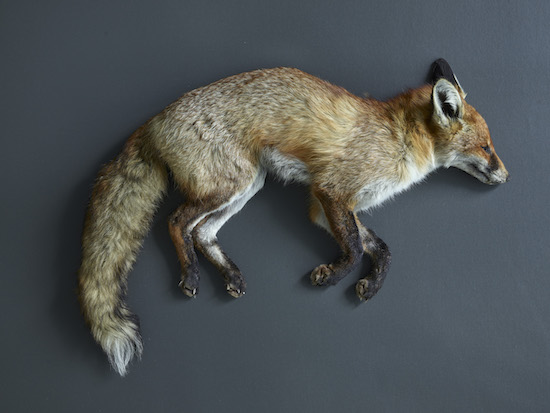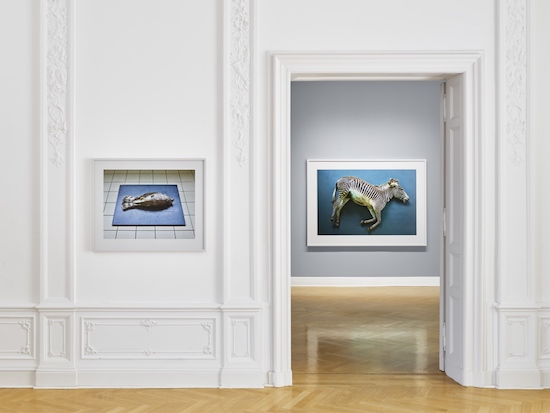Thomas Struth, installation view, Galerie Max Hetzler at Kurfürstendamm 213, Berlin, 2018
Photo: def image. Courtesy of the artist and Galerie Max Hetzler, Berlin | Paris | London
What does death look like? That’s a big one for artists – how to get us to look at what we don’t want to see. From Mantegna’s prone dead Christ through to Andres Serrano’s furtive peeking under the shroud down at the morgue, they ask – is it like this? All too often a voyeuristic violence is shown as with that horrific photograph by Enrique Metinides of the Mexican journalist Adela Legaretta Rivas taken immediately after a car killed her. Or there’s Damien Hirst’s exploitative With Dead Head (1991), the documentation of his trespass into an anatomy dissection room where he disrespectfully gurns beside a cadaver. Maybe looking at too many images of human death stops you from really seeing: anyone who has read a textbook of forensic pathology will know that lurch of distaste that announces – enough!
Thomas Struth’s new works suggest that we should look at other species to get another angle on death. His latest sequence of photographs has an oddly limited showing at Max Hetzler’s beautifully Baroque decorated outpost on the Kurfürstendamm. The shots were taken at the Leibniz Institute for Zoological and Wildlife Research in Berlin. The institute is specifically interested in how animals adapt to the Anthropocene – our current geological age, in which human activity has been the dominant influence on climate and the environment. The corpses are shown with great dignity; the animals have died naturally – there is none of the disturbing trauma of a Metinides on display here.
The works are titled with the common name of the animal first followed by the proper zoological term in the binomial nomenclature form credited to Carl Linnaeus. These are then followed by the venue and date – as with Red fox (Vulpes vulpes), Leibniz IZW, Berlin 2017 (2017). (In the interests of space from now on I’ll omit the venue). The fox is caught as if in mid-trot. We admire the snub snout, the rufous fur of its refulgent coat, the glory of its bushy brush. The other mammals here include a Hill Wallaroo (Macropus robustus) (2017) a marsupial, intermediate in size between a kangaroo and a wallaby. Like the fox it lies on a clean blue surface and again is caught on the hop, its powerful hind legs and tail contrast sharply with its tiny front paws. The Bush dog (Speothos venaticus) (2018) is pictured face on and looks as if it is merely asleep, its nose still moist, a yellow incisor pokes unthreateningly from its seemingly grinning mouth.
Threatened species co-exist here with the more successful – the Leopard cat (Prionailurus bengalensis heaneyi) (2017) is hunted for its fur in China. The one here looks young, kitten-like. The pose of the creature recalls that of a human embryo in the womb referencing the old ontogeny recapitulating phylogeny idea. A Zebra (Equus greyvi) (2017) is captured in worried mid-stride, its regular panics now at a swift end. We note the fine details of its coat, the Mohican tuft on its head, the stray hairs around its maw.
And then there are the birds, no longer in flight; these images are the most poignant. The Northern Goshawk (Accipiter gentilis) (2016) lies on its back and has its claws curved at rest liked the gnarled old hands of an arthritic pensioner. A Goliath Heron (Ardea goliath) (2017) is shown in profile, its curved S-shaped neck and pointed bill no longer stabbing into the depths for fish. Struth appears to be angling for a near Franciscan pity here. You suppress a titter at the pathos of the White-cheeked turaco (Turaco leucotis) (2017). Normally found in Eritrea it has lost much of its obvious coloured beauty and quickly calls to mind Monty Python’s dead parrot sketch. Laugh but you will be caught up short – none of us look our best in death. Apparently one of these birds – a released pet – is alive and well in the South Woodford/Leytonstone area. Finally there is the magnificent White- tailed sea-eagle (Haliaeetus albicilla) (2016), a species currently threatened by mercury and lead poisoning. This example is seen hanging upside down as if on a sharp vertical dive for prey, its amazing wingspan grandly spread out in display. Hard not to see this work as an ironic comment on German history, a land still littered with the imagery of eagles in rampant triumphalism. Witness the murmuration of fans celebrating Eintracht Frankfurt’s (Die Adler – the Eagles) cup victory now flocking down the Ku’damm…

Thomas Struth, Rotfuchs (Vulpes vulpes), Leibniz IZW, Berlin, 2017. Courtesy of the artist and Galerie Max Hetzler, Berlin | Paris | London ©Thomas Struth
Quite pointedly these dead creatures have not been stuffed. This show is not about taxidermy. This is not about thanatopraxy, an embalming to make dead animals look alive. They are not reanimated; they look dead. And, although he is clearly informed by the writings of John Berger and Jacques Derrida on the gaze of animals, Struth recognizes that their inner being is now unknowable. It’s all too late – death has rendered their gaze forever unreadable. Struth’s works here are the polar opposite of Peter Fischli and David Weiss’s video Büsi (2001) where a kitten laps at a plate of milk, a cat being a cat and only that, a cat squeezing its eyes shut as its pink tongue darts in and out of its mouth. Struth’s animal photographs are not about movement – they hone in on its absence. Death is when they (and we) cease to move – when we are all truly at rest. This is a show about stillness. Struth has talked about his interest in “the idea of surrender”. This work is about the moment when, in his words, “all the circus that you proactively create, the theatre, comes to a full stop.”
That mention of “the theatre” is significant. The critic Michael Fried has written extensively on Struth’s practice, highlighting its attention to absorption and its suspicion of theatricality. In these new animal works the play is over, the curtain has come down. Struth himself says that “these pictures should be like punches, the memento of death as a wake-up call”. They hit below the belt. They hurt because death looks like this.
Thomas Struth is at Galerie Max Hetzler @ Kurfürstendamm 213 until 2 June


